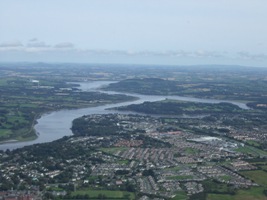| Estuaries occur as coastal embayments that come under the influence of a large river. At low water, there can be extensive areas of mudflats or sandflats. Typically, estuaries are long narrow seaward parts of river valleys, e.g., the Barrow, the Nore, the Blackwater, while areas where the river enters the sea directly with no inlet being present are not considered as an estuary habitat. Only that section of the coastal embayment or inlet that experiences reduced salinities, i.e., < 30S is regarded as estuarine, e.g., in the Shannon, only that area that is affected by reduced salinity is considered estuarine and the rest is classified as Large Shallow Inlet and Bay. Estuarine sediments are typically soft muds with a shallow redox depth due to the sheltered nature of the system and the large freshwater inputs. Where stones or shells occur, the green algaeEnteromorpha sp. and Ulva sp., and, the brown algae Fucus ceranoides and other fucoids are generally present. Salt marshes are also characteristic of estuaries. Infaunal species numbers are generally low with oligochaetes dominating. Estuaries are located on all parts of the coastline. The largest is located in the mid-west (Shannon Estuary) and constitutes approximately 50% of the national resource. |  |
| Typical Irish estuarine species include wildfowl such as Little Tern, Cormorant, Brent Goose, Oystercatcher, Dunlin, Bar-tailed Godwit, Redshank, Turnstone, Pale-bellied Brent Goose, Great Crested Grebe, Ringed Plover, Black Guillemots, Sandwich Tern, Common Tern, Shelduck, Scaup, Goldeneye, Red-breasted Merganese, Teal, Greenshank, Mallard, Knot, Golden Plover, Greylag Goose, Pintail, Grey Plover, Wigeon, Black-tailed Godwit, Curlew, Lapwing, and Sanderling. Invertebrate communities present include bivalves (Mytilus edulis), Polychaeta (Capitella spp., Malacoceros spp., Hediste diversicolor, Nereis spp, Spio spp., Magelona spp), Oligochaetes (Tubificoides benedii) and Crustacea (Corophium spp.). Algal communities comprise Ulva spp., Enteromorpha spp., the brown algae Pelvetia canaliculata, Fucus cerinoides, other fucoids, and Ascophyllum nodosum while mammals include the Harbour Seal, Grey Seal and Otter. |  |
